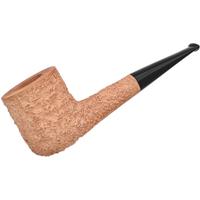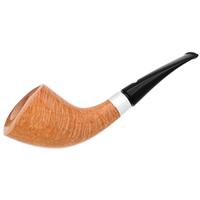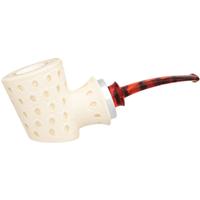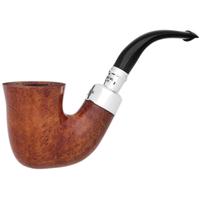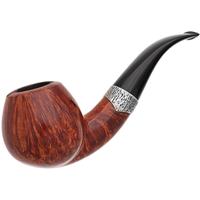I have great respect for your years of experiences in pipe smoking. But I don't think you have got some of the points in previous post. Anyway, why so serious ... I deleted the words I have put in, not the right place nor the people to talk about the science in pipes and tobacco :DThis thread has certainly some strongly held and sometimes conflicting beliefs, like briar breathing or needing to be smoked to become dry, etc.
Most of what I smoke are estate Brit wood, and the top makers thoroughly seasoned their wood before finishing. So do artisan makers like Talbert. So it's news to me that there are pipes being fashioned with green wood. Seems like a terrible idea, one that makes for lousy joinery. Nor do I find it easy to accept the notion that smoking a pipe dries it, as smoking a pipe introduces moisture into the pipe. How introducing moisture into a pipe helps dry it out is a topic I'd like to hear explained.
As for breathing, I'm reminded of the images of pipe bowls that have been bisected to reveal their cross sections. Despite years of use and hundreds of bowls smoked, they revealed little seepage of tar, or other discoloration, into the wood. The worst damage seems to be charring and cracking from clueless smokers who smoke too hot. So I'm not too convinced about breathing, either, any more than with any other wood product.
Briar isn't some alien life form. It's wood, like any other wood. It expands and contracts from changes in temperature and humidity like any other wood. Its superior fire resistance is due to the presence of silicates in the wood, not any magic.
Having a thin cake won't hurt and whether it's the thickness of a dime, or a nickel, or less, it's still a thin coat. Cake doesn't help at all at the bottom where it doesn't build up, and where burnout from "smoking it to the bottom of the bowl" and getting every last shred of leaf burnt, super heats the bowl. Making a goal of "smoking it to the bottom of the bowl" is a dumb ass practice. More dumb ass when you consider that the flavor comes primarily from the tobacco surrounding the burning leaf, not from the burning leaf itself.
Whatever interaction between smoker and pipe is taking place, it would appear to be happening primarily at a very thin depth of the inner surface, not including heat dispersion through the wood. Keeping that thin depth in good condition would seem to be the critical factor in keeping a pipe a source of enjoyment.
Do Pipes Really Get Better With Time?
- Thread starter onestrangeone
- Start date
You are using an out of date browser. It may not display this or other websites correctly.
You should upgrade or use an alternative browser.
You should upgrade or use an alternative browser.
- Status
- Not open for further replies.
I deleted the words I have put in, not the right place nor the people to talk about the science in pipes and tobacco
Rumor and innuendo are much more fun. Besides, there is no Nobel Peace Prize for the science of smoking. Let's just keep it all based on tossed chicken bones and reading tea leaves. Ha ha. Science is just too objective for my tastes. :wink:
cosmic,
Now in regards to pricing, everyone has their own price threshold and no one can just dismiss that. Too many people 400.00 is an insane price to pay for a pipe, too many others 400.00 is cheap for a pipe they like. Who are we to decide what is a stupid price to pay for a pipe?
For my money there is nothing better than getting a pristine artisan made estate pipe for 125-250.00. I would much rather spend my money for a pipe I know is going to be a great smoker, than take a guess on a new factory made pipe( with a price range of 350-650), that may be a great smoker. Now there are a few Italian made factory pipes that I would own plenty of if not for the acrylic stems.
I think that if we did not have discussions like this and over think every aspect of pipe smoking, we would be bored to tears and sites like this would cease to exsist. It is my opinion that artisan made pipes with great engineering smoke better than most factory pipes. Pipes that require no pipe cleaners to soak up moisture are preferred over pipes that gurgle and need multiple pipe cleaners while smoking. Pipes that have nice thick walls and are very good size and weigh only 40-50 grams are in many cases more desirable, than pipes that while the same size weigh 70-100 grams. Pipes with extremely comfortable stems made of the finest German vulcanite in many cases are preferrable to lousy made unomfortable acrylic stems. The engineering of a stem is as improtant as the enginering of the pipe. A badly made stem will whistle and make a pipe smoke wet.I think that we over think all of this crap. Clay pipes don't breathe, which is the mother of all pipes. Pipestone, meerschaum, etc... why do we give briar pipes all of these properties that are just totally unnecessary? Was it that goofball Newcombe? Pipemakers? Did someone have to justify charging a thousand dollars a pipe?
Now in regards to pricing, everyone has their own price threshold and no one can just dismiss that. Too many people 400.00 is an insane price to pay for a pipe, too many others 400.00 is cheap for a pipe they like. Who are we to decide what is a stupid price to pay for a pipe?
For my money there is nothing better than getting a pristine artisan made estate pipe for 125-250.00. I would much rather spend my money for a pipe I know is going to be a great smoker, than take a guess on a new factory made pipe( with a price range of 350-650), that may be a great smoker. Now there are a few Italian made factory pipes that I would own plenty of if not for the acrylic stems.
I think that if we did not have discussions like this and over think every aspect of pipe smoking, we would be bored to tears and sites like this
I totally agree...
and, there is and always has been a strong divide between skills verses the tool. Like in golf or even photography, sure the tool is important to even be able to do these things, but if you want to piss one of these guys off, give credit to their tools for being able to do a great job... "Wow, beautiful image, you must have a great camera." Or, "Wow, your clubs sure played a great game." and in so many other things we ask folks not to give too much attention to the tools, "guns don't kill people, people do." Then when we get to pipes, some give all of the credit to the pipes. Hmmm...
A great photographer can make award winning images with any hunk of junk camera, even a 1920's Brownie point and shoot. A great golfer can probably play me into the ground with a baseball bat. A great pipe smoker will find the sweet spot in any ol Grabow, MM, bucket pipe and enjoy it as much as any old Dunhill or artisan pipe out there.
That's my opinion, and I dare you to change it. :
 :
:But yeh, the fun is in the discussion. I appreciate the banter. It keeps me from just posting pictures of what I am eating on Facebook while I smoke, ha ha.
edit: I used the wrong part of the quote. Fixed to make more sense. My bad
Do pipes get better with age?
A different slant to the question. Why do we leave the smoker out of the equation. I think smokers evolve over time, perhaps become more discerning over time. I'm sure that many smoker's considerations as to what constitutes a great smoke evolve over time. A pipe that was once considered an "iffy" smoker becomes a better smoker as experience grows. The smoker learns technique, develops a taste for certain types of blends and learns how they smoke best, he/she finds shapes that are comfortable, so as the pipes age so, perhaps, does the smoker improve with age.
Smoker? Pipe? It's a combination of both I believe.
A different slant to the question. Why do we leave the smoker out of the equation. I think smokers evolve over time, perhaps become more discerning over time. I'm sure that many smoker's considerations as to what constitutes a great smoke evolve over time. A pipe that was once considered an "iffy" smoker becomes a better smoker as experience grows. The smoker learns technique, develops a taste for certain types of blends and learns how they smoke best, he/she finds shapes that are comfortable, so as the pipes age so, perhaps, does the smoker improve with age.
Smoker? Pipe? It's a combination of both I believe.
cosmic, I agree that the person smoking a pipe needs to have good skills or they are wasting the great aspects of their pipe, hot boxing any pipe will ruin the possible greatness of the pipe they are smoking. Now guys who do now how to smoke, can benefit from the great engineering and stems that an artisan made pipe can have. Of course if you have never smoked one you won't miss it, but once you do, smoking it may open your eyes to another world. After I smoked my first Rad Davis, I made a decision to go after only No American artisan made pipes and began selling off my collection of Italian and English made factory pipes,that at the time I was plenty happy with. I now own 43 No American artisan pipes and everyone is a great smoker. I won't keep a pipe that does not meet with my exacting standards.
Using your golf analogy, I was a member at the TPC Presancia in Sarasota FL for a number of years and constantly saw guys with set ups that while pretty and expensive, would never help their games. I personally have a set of custom made Titleist tour blades( 2 iron through pw, Volkey Oil Can wedges(52,60,64 degrees of loft, and the top of the line Titelist driver that I switched out for the Taylor made R5 driver and matching 3 wood, the next year,hated the Titelist driver) that for me, help my game. I grew up playing with persimmon woods and tour blades and the one time I tried cavity backed irons, my game went to shit. I still have that same set up since I bought them in 2003. I saw guys switching their set ups year after year and just laughed.
Using your golf analogy, I was a member at the TPC Presancia in Sarasota FL for a number of years and constantly saw guys with set ups that while pretty and expensive, would never help their games. I personally have a set of custom made Titleist tour blades( 2 iron through pw, Volkey Oil Can wedges(52,60,64 degrees of loft, and the top of the line Titelist driver that I switched out for the Taylor made R5 driver and matching 3 wood, the next year,hated the Titelist driver) that for me, help my game. I grew up playing with persimmon woods and tour blades and the one time I tried cavity backed irons, my game went to shit. I still have that same set up since I bought them in 2003. I saw guys switching their set ups year after year and just laughed.
. Of course if you have never smoked one you won't miss it, but once you do, smoking it may open your eyes to another world.
Although, I try to remain as modest about my collection as possible, ha ha, I do have some Beckers and other artisan mades. Funny, I have met Rad and he lives not far from me, but I have yet to get one of his pipes. But, I have quite a variety of factory and artisan.
I think that one fantastic aspect of having a homogeneous collection like yours is that you don't have to vary your style to a new genre of pipe; even your tobacco is narrowed down to just a few genres and very selective about the cure on the Virginias.
But, Even my lousiest single diameter draft holed sloppy briar work pipes can please me very well once I figure out how it wants to be smoked. But, I look for pipes with variety and also in my tobaccos also. I think that if all of my pipes were exactly the same, I would get bored.
So maybe the pipe is more important for someone who knows what style he smokes the best with. And, for others variety is the spice of life.
No wait, that is no fun. Gimme that hammer, I'm gonna take you f'n head off!!!
You're assuming what I'm assuming.You have pretty obviously been assuming your own experience to date is representative of everyone's.
I've seen pipes like that. Cake's about a mile thick on the walls and base and when it's removed during restoration you find the cracked wood underneath. Some cake will form on the base regardless, but it's not a space shuttle heat shield.My favorite old Comoy patent billiard has rock hard cake in the heel it would take a drill press with a cherry bit to grind away.
Still assuming what I'm assuming...You're assuming that smoking to the bottom involves overheating it to the point of causing burnout.
Burning those last few pathetic threads of weed put a lot of heat on the chamber. And for waht? There's no good flavor there. Burn out or other structural failure can be cause by more than one factor. Super heating time and time again can facilitate a structural failure.It does not.
Over the years I've spoken with a lot of people about pipes, not just smokers, but manufacturers and repairmen.
The repairmen are are really interesting because they're the ones who deal with the consequences of smokers' habits. They've said to me, under oath and with the lie detector strapped to their arms, that smoking every last strand isn't good for the pipe as it heats the bowl excessively.
Other smokers talk about heating the bowl excessively when going for that last bit, and that's been my experience as well. So, not just my experience, bill, just the experience of a lot of people.
The repairmen are are really interesting because they're the ones who deal with the consequences of smokers' habits. They've said to me, under oath and with the lie detector strapped to their arms, that smoking every last strand isn't good for the pipe as it heats the bowl excessively.
assume assume assume, my mechanic assumes that I use my brake too hard which caused the rotors to need turning more often. Or, that my cars tows to the left on the highway because I set in my seat wrong. A pipe repairman assumes that the smoker smokes all the way to the bottom causes burnout. I don't think that the hearsay about what a repairman has assumed is going to tread any water with me, Mr Sablebrush. Bring me the skull of repairman with his words scratched into the bone. Then the court will continue with this line of testimony. :wink:
:
 :
:I forgot to mention that their faithful dogs were facing a firing squads if the lie detectors recorded a lie. I would have used their children, but I didn't think it would be as effective.I don't think that the hearsay about what a repairman has assumed is going to tread any water with me, Mr Sablebrush. Bring me the skull of repairman with his words scratched into the bone. Then the court will continue with this line of testimony.
Well, bill, it also depends on what you're smoking. Some blends are wetter than others. As I tend to like mine on the dry side for more flavor, soggy messes are a very rare occurrence when I cut it a few strands short.
I rarely smoke aros, so I don't have the glop issue. I've also smoked the same pipe for numerous days in a row with no souring problem because I clean it out between smokes and thoroughly at the end of each day. But I rarely do that anymore. Giving a pipe a rest, and the occasional long rest seems to bring about a real benefit.
I rarely smoke aros, so I don't have the glop issue. I've also smoked the same pipe for numerous days in a row with no souring problem because I clean it out between smokes and thoroughly at the end of each day. But I rarely do that anymore. Giving a pipe a rest, and the occasional long rest seems to bring about a real benefit.
There is also the bowl shape, or more specifically, the bottom of the bowl shape to take into consideration. I know this is going to repulse you, Sable, but I find my conical shaped dublins and bulldogs cake very easy at the very bottom. The transition is very easy angled, and the very flat of the bottom is much smaller. With my best bullies and dubs, I don't try to smoke to the bottom, I just know I am done when a small bit of the fine white ash gets sucked into my mouth, easy peasy.
And, if a pipe of mine was burned out under the cake and the only way I knew about it was a repairman who was taking it down to an extreme makeover type ream job reveals it... so what? The repairman can wag a finger at me about what might happen and what caused it, till the cows come home, but for all anyone would know, a burn under the cake might just have stayed exactly that way if smoked till the cows really do come home. Unless he uses some sort of extraterrestrial voodoo mumbo jumbo to predict that it was inevitable without a doubt going to burn out, my repairman can just keep his trap shut. In fact, if a repairman wanted to advise me on anything I do, I want to see his pipe repair degree and certification. Just because there was damage under the cake, doesn't mean anything. It could be smoked for all of eternity and the cake and scar might just stay that way out of sight, out of mind. Maybe not. Life is tricky like that. : :
:
And, if a pipe of mine was burned out under the cake and the only way I knew about it was a repairman who was taking it down to an extreme makeover type ream job reveals it... so what? The repairman can wag a finger at me about what might happen and what caused it, till the cows come home, but for all anyone would know, a burn under the cake might just have stayed exactly that way if smoked till the cows really do come home. Unless he uses some sort of extraterrestrial voodoo mumbo jumbo to predict that it was inevitable without a doubt going to burn out, my repairman can just keep his trap shut. In fact, if a repairman wanted to advise me on anything I do, I want to see his pipe repair degree and certification. Just because there was damage under the cake, doesn't mean anything. It could be smoked for all of eternity and the cake and scar might just stay that way out of sight, out of mind. Maybe not. Life is tricky like that. :
 :
:Gotta agree with you about moisture, bill. But what about those folks earlier in this thread who say that smoking a pipe dries it out?
As for cake, that test is a new one on me, but I'd pass nonetheless.
As for cake, that test is a new one on me, but I'd pass nonetheless.
Really? Repulsed? Maybe if you were wearing a thong and low riders and bend over within eyesight, I might be repulsed, but about pipe cake? Nope.know this is going to repulse you, Sable, but I find my conical shaped dublins and bulldogs cake very easy at the very bottom. The transition is very easy angled, and the very flat of the bottom is much smaller. With my best bullies and dubs, I don't try to smoke to the bottom, I just know I am done when a small bit of the fine white ash gets sucked into my mouth, easy peasy.
Now if you're fond of having ash, white, gray, fine, or coarse, sucked into your mouth as part of the smoking experience, good. Not my favorite, but not the end of the known universe.
I was thinking the cone shaped bowl part. I have seen you drivel words of saccharine over them in past posts.
Really? Examples, please?I was thinking the cone shaped bowl part. I have seen you drivel words of saccharine over them in past posts.
cosmic, I have 20 Rad's and 23-24( would have to go count them and I am way too lazy to get off my ass) other artisan pipes, so my collection is not homogeneous and my pipes just told me they are very insulted, so apologize to them. I would consider that the shapes and sizes of my pipes are of a homogeneous nature. I buy Dublins, Apples, Billiards, Lovats, Rhodesians, Brandy's and one Cherrywood, one Poker and one Zulu. I only buy VA, Vaper, Vabur, and a couple of aromatic flakes. I have had plenty of years being all over the place with my pipes and tobacco. I really enjoy the strict criteria I now have for both pipes and tobacco.
Now in regards to smoking to the bottom and creating a nice cake at the bottom of the bowl. All of my pipes that have been smoked a good 25-40 times or so have a nice hard cake at the bottom which adds to my enjoyment of my tobacco. I smoke only flakes and have found that the flavors keep getting better as I smoke. I do chase flavor to the end and once in a while I will suck in some hot ash. Now if the flavors did not continue to get better, I would dump the bowl no matter how much tobacco was left, but that rarely happens. I have never burned out a pipe doing this and will not smoke a pipe that gets hot too the hand.
Now in regards to smoking to the bottom and creating a nice cake at the bottom of the bowl. All of my pipes that have been smoked a good 25-40 times or so have a nice hard cake at the bottom which adds to my enjoyment of my tobacco. I smoke only flakes and have found that the flavors keep getting better as I smoke. I do chase flavor to the end and once in a while I will suck in some hot ash. Now if the flavors did not continue to get better, I would dump the bowl no matter how much tobacco was left, but that rarely happens. I have never burned out a pipe doing this and will not smoke a pipe that gets hot too the hand.
Really? Examples, please?
What, have you gone senile on me? Or, maybe I have. But, when asked about dublins, if memory serves, I've seen you post that you did not like the conical shaped bowls... more than once.
- Status
- Not open for further replies.



